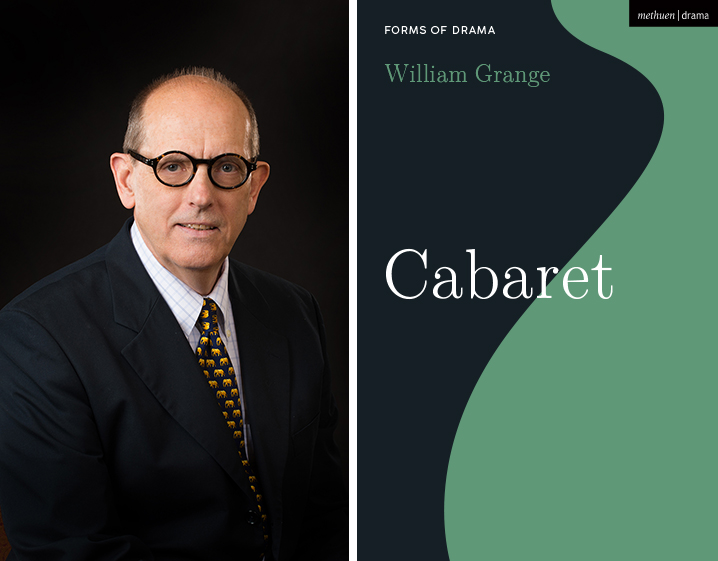
William Grange, professor of theatre in the Johnny Carson School of Theatre and Film, has recently released his 13th book, titled “Cabaret,” which is part of the Forms of Drama series from Methuen Drama in London.
In the book, Grange brings into one place for the first time the range of practices now associated with the form of cabaret. Beginning with its origins in northern Paris as poetry readings, cabaret soon spread to German, Czech, Hungarian, Polish and Russian specialty theatres. The development both of the sheet music industry and disc recordings spurred the growth of cabaret, which Grange tracks from the late 19th century to the 1950s.
“I had no idea cabaret was such a multinational thing in Europe,” Grange said. “Because it starts off in France, then goes to Germany, but then spreads very quickly throughout Europe and even to the United States. There’s a little bit that goes on in New York, but that’s during the Prohibition period.”
Grange and other scholars define cabaret as a nightclub where patrons sat at tables with alcoholic drinks and enjoyed variety acts on stage, which a master of ceremonies introduced and who interacted with the audience.
Grange also defines it as “the small space that involves an acquired set of coherencies.”
“That is, people go into the cabaret recognizing the targets of the cabaret artists,” he said. “They made fun of politicians, entertainers, pop songs, ways of dressing, ways of speaking. It’s very close to the pulse of the countries in which it blossomed and prospered.”
Its birth in Paris dates from the moment when a liqueur salesman named Rodolphe Salis invented the master of ceremonies. He was the creator, host and owner of the Le Chat Noir cabaret, the first cabaret venue in Montmartre, a village located in the far north of Paris.
“Salis really started what we now think of as cabaret,” Grange said. “Before him, it was just poets who came and read their work for free, but Salis charged audiences a ‘cover’ (admission fee) while offering beer, wine and especially liqueur at grossly inflated prices. His father was a distiller who provided the liqueur.”
Grange’s book also features an entire chapter on Aristide Bruant, the singer, songwriter and master of ceremonies who took over Le Chat Noir after Salis moved to a more posh location.
“Aristide Bruant was the Bob Dylan of 19th century France,” Grange said. “I don’t know if you’ve ever heard of him, but everybody has seen his poster because Henri de Toulouse-Lautrec created it, along with an oil painting of Bruant, the most well-known cabarettist the French ever produced. He was a real character. Arriving for shows in a black hat, a black suit, a black cape, black pants tucked into black boots as if he had traveled on horseback, Bruant topped off his outfit with a big, red scarf around his neck. He was really one of the first singer-songwriters to come along, and he was a great performer. One of his main gimmicks was to insult the audience, and the audience loved it.”
Bruant also discovered a lot of singers, most of them women. Most notable among them was Yvette Guilbert, a dainty woman who wore an evening gown and elbow-length gloves, singing naughty songs about prostitutes and their pimps, just as Bruant had done. Most of her songs were subtle, and when she came to Chicago in 1896, Grange said nobody could understand a word she sang.
“Sexual innuendo was a hallmark of cabaret, not matter where it was performed,” Grange said. “Insults, put-downs and mockeries were abundant. Masters of ceremonies soon became adept in various languages in the art of derision, in some ways similar to what takes place on shows like ‘Saturday Night Live.’”
But it’s also intellectual.
“Cabaret artists often subjected politicians and other Establishment figures to abuse, as if they were abstract pinatas,” Grange said. “But in cabaret, it’s much more intellectual. The impact depended on the collectively acquired sentiment of coherency among the audience. To do cabaret, you’ve really got to be topical because if you do a set of jokes about a politician, who is doing something this week, everybody will have forgotten it a month later.”
“Cabaret” and his other recent book, “The Business of American Theatre,” were both published during the pandemic.
“It [“Cabaret”] really saved me because it was more fun than anything I’ve ever written,” Grange said. “All these books I’ve written are very academic. This is a little more on the lighter side. You can laugh while you read it, which rarely happens in books I write.”
Grange has also written dozens of scholarly essays, book chapters, journal articles, reviews and encyclopedia entries. He was a guest professor at the University of Heidelberg’s Center for American Studies, the Distinguished Chair in Humanities and Cultural Studies at the University of Vienna, and a Fulbright Professor at the University of Cologne.
For more information or to order “Cabaret,” visit the book’s page on Amazon at https://go.unl.edu/grange13.